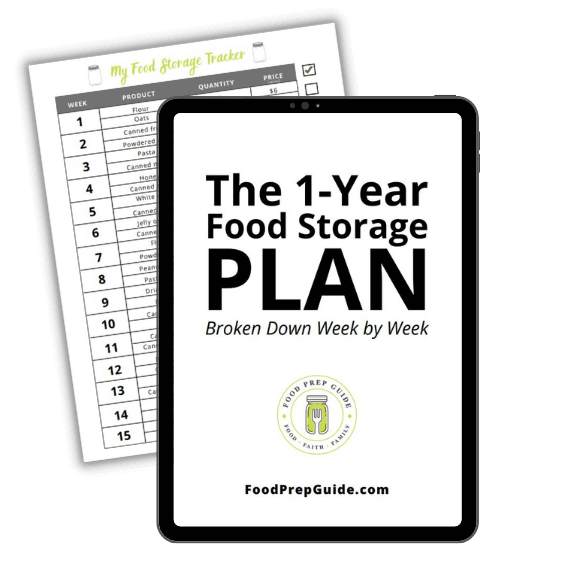I don’t know how you landed on this article today, but I’m sure glad you did.
People have all sorts of reasons for wanting to stock a pantry with a year’s supply of food.
I don’t know what your reason may be but, if you’ll let me, it would be an honor and a privilege to teach you how to meet your goal.
Why Stock a Pantry with a Year’s Worth of Food?
Having a pantry stocked with a year’s worth of food can provide you with a sense of security and peace of mind. In times of uncertainty or emergencies, your family can still access necessary groceries and ingredients.
Plus, you’ll be prepared for unexpected situations like job loss, natural disasters, or even a pandemic.
A fully stocked pantry can also save you time and money. Buying in bulk can be more cost-effective, particularly when it comes to non-perishable items that have a long shelf life.
Additionally, by having a variety of pantry staples on hand, you can cut down on those last-minute trips to the grocery store, which often result in impulse buys and extra spending.
Another advantage of having a year’s worth of food in your pantry is the ability to enjoy seasonal produce throughout the year.
By preserving or freezing fruits and vegetables when they’re in season, you can indulge in their fresh taste during the off-season, making your meals more varied and enjoyable.
A well-stocked pantry is both practical and prudent.
FREE FOOD STORAGE PLAN!

Does gathering and storing a year’s worth of food for your family seem overwhelming and unachievable?
Make it easy with our step-by-step plan. Subscribe to our weekly newsletter & we’ll send it to you FREE!
The Strategy: Reverse Engineer Your Pantry
To create a pantry that will last for a year, you’ll need to start by thinking about your favorite recipes and the ingredients you use most often.
This is the reverse-engineering process, where you’ll build a list of essentials to stock, ensuring you have what you need to prepare your favorite meals.
Begin by listing out your go-to dishes and their key ingredients, including spices, dry goods, and canned items. Don’t forget to consider staple items like rice, pasta, beans, and grains, as well as baking essentials like flour and sugar.
Here’s a video discussion if you’d rather watch than read. 🙂
Consider the following points when building your list:
- Frequency of use: Focus on ingredients you use regularly, not just ones you use occasionally or for special occasions.
- Shelf life: Prioritize items with longer shelf lives, like canned goods, grains, and dried vegetables.
- Storage: Make sure you have enough space in your pantry to store all of your essentials. Plan your storage in an organized manner, grouping similar items together.
- Budget: Be mindful of your overall budget, tracking the cost of your items and shopping at different stores to find the best deals.
Lastly, remember to maintain your pantry by regularly, checking your stock levels and replenishing when needed. This proactive approach will ensure your pantry remains well-stocked, with a variety of ingredients for all your culinary needs.
What to Expect When Stocking Your Pantry for a Year
The following categories can help guide your pantry-stocking journey:
Carbohydrates
Carbohydrates—such as grains, pasta, and rice—are essential for energy and a key component of your pantry. Choose a variety of options with varying cooking times and flavors, such as:
- Long grain white rice
- Brown rice (not as long of a shelf-life as white rice)
- Quinoa
- Pasta (spaghetti, penne, macaroni)
- Rolled oats
Proteins
Protein is important for muscle growth and repair, so you’ll want to stock up on both animal-based and plant-based sources. Include options like:
- Canned beans (black, kidney, chickpeas)
- Lentils
- Peanut butter
- Canned tuna or salmon
- Dried, nonperishable meats (e.g., jerky)
- Canned chicken
Fruits & Vegetables
Although fresh fruits and vegetables have shorter shelf lives, you can still maintain a healthy and balanced pantry by stocking canned, dried, or frozen versions. Remember to focus on variety:
- Canned vegetables (corn, green beans, peas)
- Canned fruits (peaches, pears, pineapple)
- Dried fruits (raisins, apricots, prunes)
- Frozen fruits (berries, mango chunks)
- Frozen vegetables (spinach, broccoli, peas)
Baking Essentials
If you enjoy baking, you’ll want to make sure your pantry is stocked with essential ingredients. Save time by keeping these staples on hand:
- All-purpose flour
- Granulated sugar
- Brown sugar
- Yeast
- Baking powder
- Baking soda
Spices and Seasonings
Spices and seasonings can easily transform a dish, so keep your pantry stocked with a variety of options:
- Salt
- Pepper
- Cumin
- Paprika
- Garlic powder
- Onion powder
- Dried herbs (basil, oregano, rosemary)
Oils and Vinegars
Lastly, oils and vinegars are key ingredients for cooking and salad dressings. Make sure to include some of the following options in your pantry:
- Olive oil
- Canola oil
- Balsamic vinegar
- Apple cider vinegar
- Red wine vinegar
By focusing on these categories and ensuring a variety of options, you’ll have a well-stocked pantry that will provide you with diverse meal possibilities for an entire year.
Meal Planning From Your Food Storage Pantry
A helpful tip is to organize your pantry based on the type and expiration date, so it’s easier to know what you have and use it before it spoils.
Here are some simple meal ideas using your pantry essentials:
- Pasta dishes: Get creative by using different types of pasta and pairing them with various sauces, vegetables, and proteins.
- Rice bowls: Make a delicious rice bowl by mixing cooked rice with beans, canned veggies, and your choice of spices or seasonings.
- Soups: Begin with a base of broth and add beans, pasta, rice, or potatoes and any canned or frozen vegetables you have on hand.
- Potato-based meals: Get creative by making potato soup, hash browns, or using them as a side for your main dish.
We actually have a collection of meal plans that feature common food storage ingredients if you’re interested:

Remember that shopping in bulk can save you time and money in the long run. When purchasing staple items, consider buying in bulk to save on costs and reduce shopping trips.
Finally, always be sure to plan your meals around what you have in your pantry. This will prevent food waste, save money, and ensure that you’re consuming a balanced diet. Keep a running list of recipes you enjoy, so you’ll never run out of ideas when planning your meals throughout the year.
As you adapt to cooking from your food storage pantry, you’ll find it easier to navigate and maintain your stock, leading to more efficient meal planning and a well-stocked pantry all year long!
Don’t forget your free 1-year food storage plan:
FREE FOOD STORAGE PLAN!

Does gathering and storing a year’s worth of food for your family seem overwhelming and unachievable?
Make it easy with our step-by-step plan. Subscribe to our weekly newsletter & we’ll send it to you FREE!










